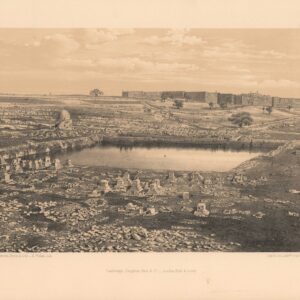A graphic vista of Amman as a modern Arab Metropolis, published less than a decade after Jordanian Independence.
Amman in Panorama
Out of stock
Description
An unusual map that captures the bustling metropolis of Amman during its formative days as Jordan’s capital city. It was produced by one of the city’s great publishers and book dealers: the Istaklal Library. Still a major supplier of office and publishing supplies, the Istaklal company has come to stand as one of those family firms that helped push a newly autonomous Jordan into modernity.
The map was drawn in 1952 by the Russian-Palestinian painter George Aleeff, and subsequently published as a lithograph by the Beirut-based printer Joseph S. Saikali. It has a deliberately contemporary aesthetic, as if it was conceived directly into the mid-century modern style that characterized home decor in the mid- to late 1950s.
It is a map that not only portrays Amman as a locus of modernity in the Middle East, but which also reflects a deeper national self-awareness. Only a country of some maturity, well-prepared both structurally and intellectually for autonomous rule, has the analytical foresight and capacity to use cartography to delineate national spaces. This is perhaps especially valid for a map which is as aesthetic as this one: this is a project of national pride and distinction, a symbol of Jordan’s legitimacy in claiming independence. This ambition is of course further echoed in the name selected by the publisher (Istaklal = Independence).
The map was printed in black and white, with urban blocks drawn as black quadrants in various sizes and lining major thoroughfares. People familiar with Amman’s geography will certainly recognize many elements, but may also find many aspects of the city almost unrecognizable. An important aspect to note about this map is what kind of institutions and sights have been included at the expense of others. An example of this is the discrete presence of Amman’s historical heritage. The map highlights elements such as the ancient citadel and the city’s monumental Roman amphitheater in the form of small vignettes. Also included are the offices of a newly established Jordanian Department of Antiquities, clearly visible at the top of the map, in what today is known as Jabal Amman.
A closer look at the map reveals a focus on the coherence of a national concept, and thus a national homeland, found for example in the prominence afforded the various palaces and complexes of the Hashemite ruling family. These include the still famous Raghadan Palace, which was constructed by King Abdullah I in 1926 and to this day remains an important architectural symbol for Hashemite legitimacy and Jordanian independence. Other palaces have received similar attention in the form of illustrated vignettes and clear labeling. The mapmaker has also featured buildings related to modern education and to international business in a similar manner.
The fact that the map was executed in English rather than in Arabic says something about its target audience. There are ample references to international or European affiliations, which do not necessarily harken back to the days of the British Protectorate, but which do speak to the kinds of people that Istaklal was producing this map for: essentially foreigners. The international component includes the British and American Residence buildings, the Italian Hospital, the British, American and French embassies, Armenian and Greek Orthodox churches, and of course major companies such as Shell and The Vacuum Oil Company. In the lower right of the map we find a numbered legend pinpointing a much broader range of buildings and locations throughout the city. In this way, the map constitutes a depiction of both the concrete effects of European intervention in this part of the world, as well as of the national ambitions and self-confidence of Jordan following the Second World War.
Rarity
The map is extremely rare. We note no examples on OCLC, although there seems to be an example which has been imaged for the Geospatial projects at MIT, Harvard and Stanford (which seems to be the same example).
There are no auction or dealer records for the map having been offered for sale (we co-own this map with BLR Rare Maps in La Jolla).
Cartographer(s):
George Aleeff (1887-1970) was a Russian painter and graphic artist who had originally served as a private bodyguard to Tsar Nikolai II. Following the Russian revolution, Aleeff joined the White Army, fighting for the reinstatement of the Tsarist regime. However, with the execution of the entire Russian royal family at the hands of Lenin’s Bolsheviks and the defeat of the Tsarist White Army, Aleeff fled to Palestine. Here, he settled and began painting scenes that captured some of the historical events which eventually would lead to independence for the countries of the region. A staunch supporter of Palestinian independence, Aleeff rejected the new Jewish state and ended up fleeing Palestine for Jordan as part of the great Palestinian Exodus in 1948. For the rest of his life, he lived in Jordan as an exile, serving his new country as loyally and diligently as he had the country of his birth.
Istaklal Publishing HouseThe Istaklal Publishing House was founded by Hasan R. Khalaf in 1940 as a publisher for modern educational books in Jordan. The company later expanded to include all forms of office supplies. The name celebrates Jordan’s long goal of achieving independence, first from Turkish Ottoman rule, and later from British governance. It was created with the ambition of supplying all of Jordan’s schools with the necessary books, and later supplying the new administration with the necessary tools for education, knowledge sharing, record-keeping, and general administration.
Condition Description
Very good.
References




